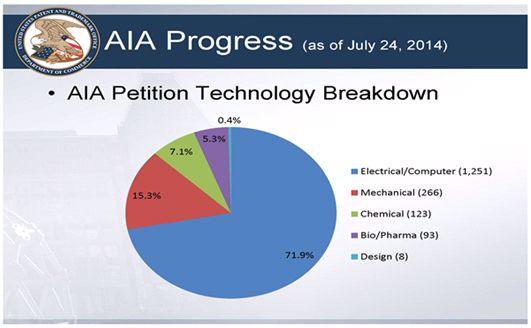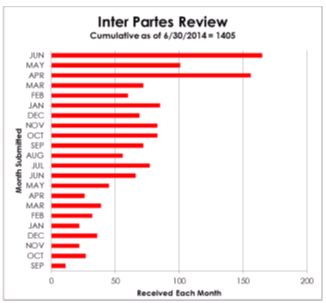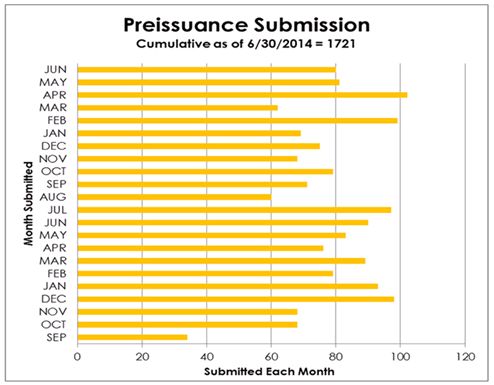The Leahy-Smith America Invents Act (the "AIA"),1 provides three types of third party challenges: Post Grant Review,2 Inter Partes Review including Covered Business Method Patent Inter Partes Review,3 and Preissuance Submissions.4 Companies should familiarize themselves with the potential benefits of these three types of litigation alternatives, which in some cases, may enable them to avoid litigation completely.
This Stroock Special Bulletin provides statistics, where available, with regard to these three litigation alternatives.
Overall, the Patent Office has released the following statistics on the technology breakdown for Inter Partes Review including Covered Business Method Inter Partes Review:

Post-Grant Review – Within Nine Months from Patent Grant
Section 6 of the AIA adds Chapter 32 to title 35 of the United States Code. This new chapter allows any third party to request the cancellation of one or more claims of a patent, on any ground that could be raised under defenses (2) or (3) of 35 U.S.C. § 282, by petitioning for post-grant review of the patent. This petition must be filed within nine months of the date the patent is granted or the date the reissue patent is granted.
Post-grant review is available so long as the petitioner has not previously challenged the patent's validity in a civil action. Post-grant reviews will be undertaken by a three-member panel from the newly created Patent Trial and Appeal Board (the "Board"), consisting of persons with legal knowledge and scientific ability (typically, ex parte examinations or ex parte reexaminations are before a single Examiner).
The post-grant review will be granted upon a showing that it is more likely than not that at least one of the challenged claims is unpatentable, or that the petition raises a novel or unsettled legal question important to other patents or applications. If a petitioner files a civil action after it files a post-grant review petition, the civil action is automatically stayed until the patent owner either moves the court to lift the stay or files a civil action or counterclaim alleging infringement against the petitioner.
The third party petitioner will have the burden of proving unpatentability by a preponderance of the evidence. Patent owners will be permitted to amend claims without enlarging the scope or introducing new matter. In addition, limited discovery will be permitted during the proceeding, including the opportunity to depose witnesses submitting a declaration relied upon by the third party or patent owner. Protective orders will be provided to protect the exchange and submission of confidential information. In addition, either party may request an oral hearing before the Patent Trial and Appeal Board.
A final written decision must be issued by the Patent Trial and Appeal Board not later than one year from the institution of the review, extendable by an additional six months upon a showing of good cause. A post-grant review may be terminated upon the joint request of the petitioner and the patent owner, unless the Board has decided the merits before such request. If the post-grant review is terminated – such as pursuant to a settlement agreement – no estoppel will attach to the petitioner, or to the real party in interest or privy of the petitioner, on the basis of that petitioner's institution of that post-grant review.
A post-grant review may not be instituted if, before the date on which the petition for a review is filed, the third party petitioner or real party in interest filed a civil action challenging the validity of a claim of the patent (i.e., a preemptory declaratory judgment action for patent invalidity). If the petitioner or real party in interest files a civil action challenging the validity of a claim of the patent on or after the date on which the petitioner files a petition for a post-grant review of the patent, that civil action will be stayed automatically until the patent owner moves the court to lift the stay, the patent owner files a civil action or counterclaim alleging that the petitioner or real party in interest has infringed the patent, or the petitioner or real party in interest moves the court to dismiss the civil action.
A counterclaim challenging the validity of a claim of a patent does not constitute a civil action for purposes of determining whether an accused infringer may file a request for post-grant review. However, a post-grant review may not be instituted if the petition requesting post-grant review is filed more than one year after the date on which the petitioner was served with a complaint alleging infringement of the patent.
The petitioner in a post-grant review of a claim that results in a final written decision may not request or maintain a proceeding before the Patent Office with respect to that claim on any ground that the petitioner raised or reasonably could have raised during that post-grant review. In addition, a petitioner in a post-grant review of a claim that results in a final written decision may not assert in a civil action that the claim is invalid on any ground that the petitioner raised or reasonably could have raised during that post-grant review.
Any proposed amended or new claim determined to be patentable and incorporated into a patent following a post-grant review will have the same intervening rights as that specified in 35 U.S.C. Section 252 for reissued patents on the right of any person who made, purchased, or used within the United States, or imported into the United States. Any party may appeal the post-grant review final written decision of the Board only to the Court of Appeals for the Federal Circuit.
As of June 30, 2014, the Patent Office has reported that a total of 186 Covered Business Method reviews have been initiated:

Because post-grant reviews can only be filed on patents issued from applications having an effective filing date of March 16, 2013 and later, there are not currently available any significant statistics for this procedure of the America Invents Act.
Inter Partes Review – After Expiration of Post-Grant Review
Section 6 of the America Invents Act also replaces the inter partes reexamination with the new inter partes review procedure to be conducted by the new Patent Trial and Appeal Board (the "Board"). Under inter partes review, patents can only be challenged on the basis of novelty and non-obviousness and third party challengers may only submit patents or printed publications as the basis for review. The Patent Office will only institute an inter partes review upon a showing of a reasonable likelihood that the petitioner will prevail in the proceeding with respect to at least one claim. The America Invents Act does not, however, change ex parte reexaminations, including the standard of substantial new question (SNQ) of patentability.
Inter partes review is intended to be a relatively quick proceeding for challenging a patent's validity in the Patent Office. Inter partes review may take place after the nine-month period for initiating post-grant review proceedings has expired, or after a post-grant review has concluded. A petition for inter partes review must show by a preponderance of the evidence – i.e., that it is more likely than not – that at least one of the claims of the challenged patent is unpatentable.
The petition for inter partes review must be accompanied by a fee, identify all real parties in interest, and identify the grounds on which each claim is challenged, with supporting evidence, including any supporting affidavits or declarations. The patent owner may file a preliminary response to the petition in an effort to persuade the Director not to grant the petition for review.
The "reasonable likelihood" standard is a more difficult standard to meet than the substantial new question of patentability (SNQ) required in ex partes reexaminations. The Director will determine whether to institute an inter partes review within three months after the patent owner's preliminary response to the petition is received. If no preliminary response is filed by the patent owner, the Director will determine whether to institute an inter partes review within three months after the last date on which the preliminary response could have been filed. The decision of the Director whether to institute an inter partes review is not appealable.
Inter partes reviews will be conducted by the Patent Trial and Appeal Board (formerly the Board of Patent Appeals and Interferences), rather than the Central Reexam Unit (CRU) which conducts inter partes reexaminations at present. The third part petitioner will have the burden of proving unpatentability by a preponderance of the evidence. Patent owners will be permitted to amend claims without enlarging the scope or introducing new matter. In addition, limited discovery will be permitted during the proceeding, including the opportunity to depose witnesses submitting a declaration relied upon by the third party or patent owner. Protective orders will be provided to protect the exchange and submission of confidential information. In addition, either party may request an oral hearing before the Patent Trial and Appeal Board.
A final written decision must be issued by the Patent Trial and Appeal Board not later than one year from the institution of the review, extendable by an additional six months upon a showing of good cause. A post-grant review may be terminated upon the joint request of the petitioner and the patent owner, unless the Board has decided the merits before such request. If the post-grant review is terminated, such as pursuant to a settlement agreement, no estoppel shall attach to the petitioner, or to the real party in interest or privy of the petitioner, on the basis of that petitioner's institution of that post-grant review.
An inter partes review may not be instituted if, before the date on which the petition for a review is filed, the third party petitioner or real party in interest filed a civil action challenging the validity of a claim of the patent, i.e., a preemptory declaratory judgment action for patent invalidity. If the petitioner or real party in interest files a civil action challenging the validity of a claim of the patent on or after the date on which the petitioner files a petition for inter partes review of the patent, that civil action will be automatically stayed until the patent owner: moves the court to lift the stay; the patent owner files a civil action or counterclaim alleging that the petitioner or real party in interest has infringed the patent; or the petitioner or real party in interest moves the court to dismiss the civil action.
A counterclaim challenging the validity of a claim of a patent does not constitute a civil action for purposes of determining whether an accused infringer may file a request for inter partes review. However, an inter partes review may not be instituted if the petition requesting inter partes review is filed more than one year after the date on which the petitioner was served with a complaint alleging infringement of the patent.
The petitioner in an inter partes review of a claim that results in a final written decision may not request or maintain a proceeding before the Patent Office with respect to that claim on any ground that the petitioner raised or reasonably could have raised during that inter partes review. In addition, a petitioner in an inter partes review of a claim that results in a final written decision may not assert in a civil action that the claim is invalid on any ground that the petitioner raised or reasonably could have raised during that inter partes review.
Any proposed amended or new claim determined to be patentable and incorporated into a patent following an inter partes review will have the same intervening rights as that specified in 35 U.S.C. Section 252 for reissued patents on the right of any person who made, purchased, or used within the United States, or imported into the United States. Any party may appeal the inter partes review final written decision of the Board only to the Court of Appeals for the Federal Circuit.
As of June 30, 2014, the Patent Office has reported that a total of 1,405 Inter Partes Reviews have been initiated:

In addition, the Patent Office has released the following statistics regarding the progress of Inter Partes Reviews and Covered Business Method Inter Partes Reviews that have been initiated:

Pre-Issuance Submissions – During Patent Application Pendency
Section 8 of the America Invents Act provides the ability for third parties to submit relevant prior art during the pendency of patent applications. Under the new 35 U.S.C. § 122(e), any third party may submit any patent, published patent application or printed publication for consideration by the Patent Office during prosecution, provided the third party includes a description of the relevance of each submitted document. The deadline for the submission is the later of either a first rejection of the application or within six months of the date the application is published. Once the patent application receives a notice of allowance, the third party is no longer permitted to provide the submission.
As of June 30, 2014, the Patent Office has reported that a total of 1,721 Preissuance Submissions have been filed:

Conclusion
The three types of third party challenges under the Leahy-Smith America Invents Act may be an attractive option for parties that would benefit from an early ruling on patent validity. For example, a party may want to attempt to clarify and limit the scope of claims of the patent applicant or patent owner through the use of the third party challenges to enhance its ability to avoid the patent and/or develop a non-infringing alternative. Third parties, however, must weigh the benefits of utilizing the third party challenges versus their potential adverse impact. In some instances, the risks of broader potential estoppels that might attach in litigation will override the advantages that these third party challenges may provide.
Even though the earliest that any of these challenges become effective is September 16, 2012, the Patent Office has been busy writing regulations to implement third party challenges under the Leahy-Smith America Invents Act. The following final rules have been published by the Patent Office:
- Preissuance Submission Final Rules (77 Fed. Reg. 42150, July 17, 2012) (located at http://www.uspto.gov/aia_implementation/120707-preissuance_submission_fr.pdf).
- Inter Partes, Post Grant, and Covered Business Method Review Final Rules (77 Fed. Reg. 48680, August 14, 2012) (located at http://www.uspto.gov/aia_implementation/fr_specific_trial.pdf ).
- Covered Business Method and Technological Invention Definitions Final Rules (77 Fed. Reg. 48734, August 14, 2012) Changes to Implement Inter Partes Review Proceedings, 77 Fed. Reg. 7041 (February 10, 2012) (located at http://www.uspto.gov/aia_implementation/fr_covered_business_method_definition.pdf).
- Statistics for Inter Partes, Post Grant, and Covered Business Method Review (located at http://www.uspto.gov/aia_implementation/statistics.jsp and http://www.uspto.gov/ip/boards/bpai/stats/aia_trial_statistics.jsp).
Footnotes
1.Leahy-Smith America Invents Act (AIA), Pub.L. 112-29, H.R. 1249, Sections 6 and 8, enacted September 16, 2011.
2.Patents that are eligible for Post Grant Review (PGR) generally include patents issued from applications having an effective filing date of March 16, 2013 and later, as well as certain business method patents regardless of filing date under the Transitional Covered Business Method Patent Inter Partes Review proceedings as of September 16, 2012.
3.Patents that are eligible for Inter Partes Review (IPR) are those patents that issued before, on, or after September 16, 2012. Thus, unlike in Inter Partes Reexamination which only includes patents that issued from applications filed after November 29, 1999, all patents are eligible for IPR.
4.Patents that are eligible for Pre-Issuance Prior Art Submissions by third parties are all patent applications regardless of filing date starting on September 16, 2012.
The content of this article is intended to provide a general guide to the subject matter. Specialist advice should be sought about your specific circumstances.
